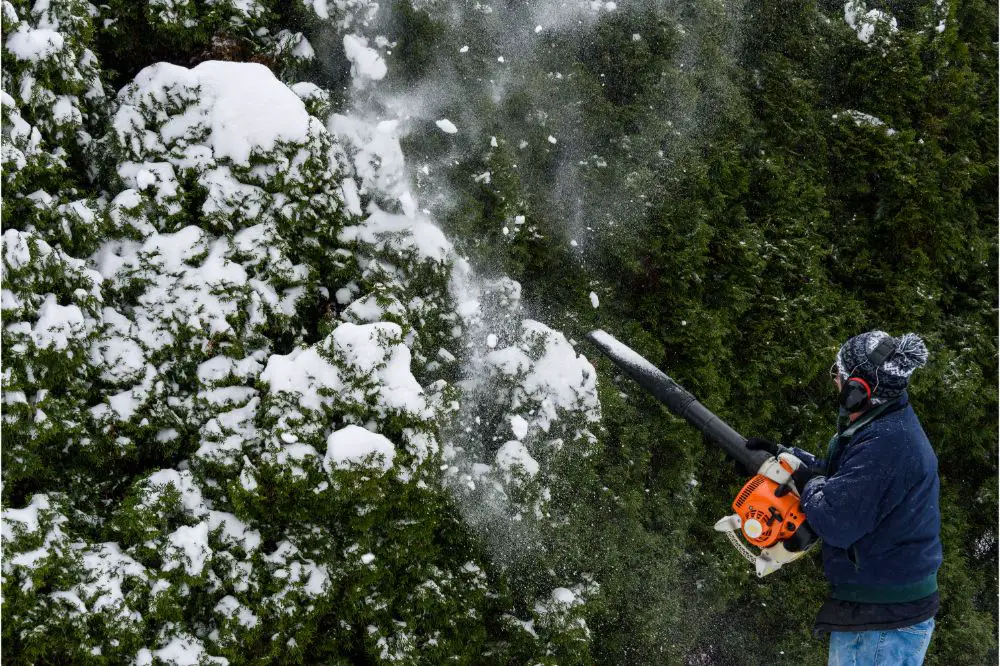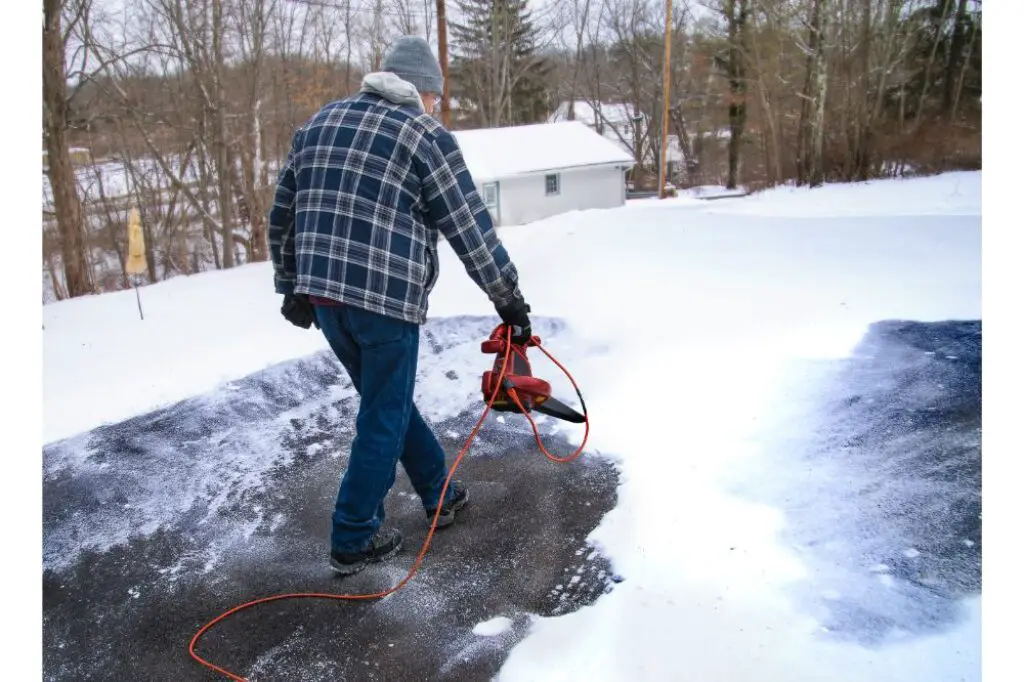GardenerHeaven.com is reader-supported. When you buy through links on our site, we may earn an affiliate commission.

A leaf blower is an outdoor power tool that uses high-pressure air to remove leaves, debris, and snow from driveways, sidewalks, and lawns. The device has a rotating cylinder that can be adjusted to blow either sideways or straight up to clear debris off of surfaces.
Now about the question: Is a leaf blower effective for snow clearing? Let’s take a look at the answer to this question to find out!
Can You Use a Leaf Blower for Snow
Yes, it is possible but only for certain situations. Leaf blowers work the same way as snow blowers, using air to blow off light objects like leaves and small debris.
You need to consider the differences between snow and leaves. While leaves can be dry and light, snow is wet, heavy, and packed.
These differences make it more difficult to blow snow with a leaf blower than when you remove leaves.
These are some things to consider before you use your leaf blower for clearing the snow.
Volume of Snow
A leaf blower can be used to remove some snow from your deck, patio, or driveway.
You will need to use it only on snow less than 4 inches thick. Anything higher than that and your leaf blower’s motor may not be capable of handling it.
You will also need to keep it in use for a limited time to prevent moisture build-up and engine failure. It will take you a long time to blow snow from thick piles, and your leaf blower may break down.
Additionally, snow piles that are thicker and heavier may require a snow blower to remove everything.
Light vs. Heavy Snow
You shouldn’t use your leaf blower to move large rocks. Snow that accumulates tends to become extremely heavy and packed.
Your typical leaf blower will not be able to remove it, even at maximum power. A few unfortunate outcomes could result. First, overexerting your engine can cause your leaf blower to overheat and eventually break.
Second, it is possible to spread the snow around rather than blow away. Third, heavy snow can withstand strong leaf blowers, generally speaking.
Although you can remove some of the top layers, it will be impossible to blow away once it has consolidated.
Wet vs. Dry Snow
Understanding if you can use a leaf blower is nearly the same thing as distinguishing between dry and wet snow.
As we mentioned above, your leaf blower should not be used on heavy snow. Wet snow is heavier than powdery, dry snow. It is, therefore, more difficult to move with a leaf blower.
Even though a leaf blower is heavy-duty, it should still be capable of handling a little bit of snow.
It is important to test the engine first. You must also ensure that the snow doesn’t get in the machine. It is best to avoid wet snow to ensure your leaf blower doesn’t go down too soon.
However, it is fine to use your leaf blower with dry snow. It is light and easy to blow with your leaf blower.

Safety Tips When Using a Leaf Blower to Remove Snow
Leaf blowers can be used to clear snow. However, it is essential to remember to exercise caution when using them for any other purpose.
Blowing away leaves is very different from blowing snow. Therefore, it is not surprising that using a leaf blower to blow snow can pose some hazards or disadvantages.
These are some things to remember.
A Gas-Powered Leaf Blower Is Best
Both cordless and electric leaf blowers can be used conveniently and easily. However, they aren’t the best choice for blowing snow away. Snow is made of ice crystals that melt into water. Water and electricity can make dangerous combinations.
You run the risk of moisture building up inside your leaf blower’s motor or engine when you use it to remove snow, and your machine may short-circuit or even break. It can even lead to serious injuries if you’re not careful.
Additionally, electric leaf blowers are less powerful than their gas-powered counterparts. Therefore, a gas-powered unit is safer and more efficient if you deal with lots of snow.
Select a Strong Model
You should not attempt to blow snow with a leaf blower unless certain. Snow is heavier and denser than dry leaves and requires more power to blow away.
A handheld leaf blower with low CFM or MPH will not suffice to remove snow. Instead, you should opt for units with at least 1,000 CFM to maximize your fighting chances.
It is wise to choose reliable brands that have a history of producing durable, high-quality equipment.
Do Not Use for Prolonged Periods
Your leaf blowers may be less effective at clearing snow than snow blowers. However, this does not mean that you should use them to remove all the snow! You should, however, only use your leaf blower for short periods.
When it stops working as efficiently and is put away in a dry area, clearing snow requires the engine to do more than leaf blowing. Leaf blowers cannot be used for long periods and will eventually wear out.
Take Into Account the Temperature Outside
Leaf blowers are not capable of handling extreme cold like snow blowers. It is, therefore, best not to use one when temperatures are extremely low, as your machine may malfunction.
If the blower accidentally electrocutes your hand, you may sustain injuries. Therefore, only use the machine when it is not snowing, or the temperature is not too cold. To protect your leaf blower from the elements, keep it dry and in good condition.
Conclusion
Yes, you can use a leaf blower for snow, but you should consider the tips mentioned above. You should also be careful about how much wind you create when using your leaf blower for removing snow and make sure that you don’t blow any ice onto your house or car.




